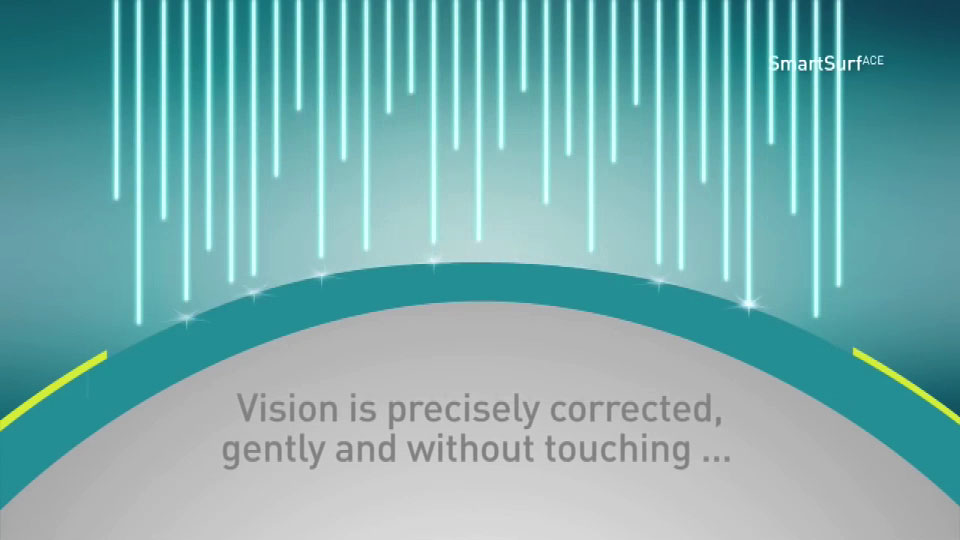TransPRK (No-touch PRK)
SCHWIND AMARIS Excimer Laser SmartSurf ACE Technology - TransPRK - No touch Video
What is TransPRK (No-touch PRK)?
Advanced Surface Ablation (ASA) is a term to describe a family of laser eye surgery that includes, PRK (Photorefractive Keratectomy), LASEK (Laser Epithelial Keratomileusis), and TransPRK or No-touch PRK. ASA may be used to correct myopia (near-sightedness), hyperopia (far-sightedness) and astigmatism. ASA is the precursor of LASIK and is still widely performed and accepted.

TransPRK is a "no-touch" version of the PRK procedure. While in PRK, the outer layer of the cornea is removed by the use of alcohol or mechanical means, TransPRK (which has sometimes also been called No-touch PRK) removes this layer with the same laser which corrects the patient’s refractive error. Thereby transforming PRK into a one-step, no touch procedure, improving accuracy by removing steps and their accompanying variability. Doing this also speeds up and smoothens the healing process as compared to conventional PRK as the wound is made only as big as the planned ablation zone. TransPRK has the same indications as Soft-touch PRK and its results are comparable with that of LASIK and other versions of PRK/ Advanced Surface Ablation procedures.
How does TransPRK correct myopia (short-sightedness)?
The excimer laser is used to reduce the curvature or power of the cornea so that light rays will bend less, and the focal point is then shifted from being in front of the retina onto the retina surface instead. This will allow images from a distance to be in focus.
How does TransPRK correct hyperopia (long-sightedness)?
The excimer laser is used to increase the curvature or power of the cornea so that light rays are bent more, and the focal point is then shifted from behind the retina onto the retina surface instead. This will allow images of near objects to be seen clearly.
How does TransPRK correct astigmatism?
The excimer laser is used to even out the curvature of the cornea, by smoothening the contour to be more round, like changing the shape of a rugby ball to that of a soccer ball.
TransPRK Procedure
The Schwind Amaris laser gently ablates the surface epithelium cells followed immediately by reshaping the cornea curvature to correct the patient’s myopia.
Post-treatment Step
Cornea epithelium regenerates itself in 3–5 days with the help of the 'bandage' soft lens which promotes healing, reduces post-op discomfort and acts as an artificial flap.
Who is suitable for TransPRK?
TransPRK (it has sometimes also been termed No-touch PRK) is for people who have refractive errors but whose corneas that may not be suitable for LASIK. It is also for people whose jobs or lifestyles put them at risk of eye trauma. The long-term visual outcome of TransPRK is comparable to LASIK but the recovery period is longer.
You will need to go through a comprehensive pre-procedure assessment, where our doctor and his team will check your eyes comprehensively to determine your suitability for TransPRK Surgery. Here are some factors to determine your suitability:
-
Has your vision been stable long enough to have TransPRK Surgery?
If your spectacle power is still increasing, it would be advisable to wait till it stabilises.
-
What is your corneal shape and corneal thickness?
Patients with evidence of Keratoconus (conical-shaped cornea) are not suitable for TransPRK. This is a condition where the cornea becomes thinned out and weakened causing unusual astigmatism and poor vision. In these cases, Implantable Collamer Lens (ICL) may be a better/safer option.
-
Are you currently pregnant or breastfeeding?
Hormonal changes, affect your cornea’s properties and fluid retention can cause vision fluctuations in women who are pregnant or actively nursing. To get the best results for TransPRK and other types of vision correction surgery, it is advisable to undergo surgery when one is neither pregnant nor breastfeeding.
-
Do you have dry eyes?
If you have dry eyes, you may be advised to have that treated prior to vision correction surgery (e.g. TransPRK, PRK, LASIK, SMILE etc.) as this can affect healing after eye surgery especially if your eyes become dryer post-operatively.